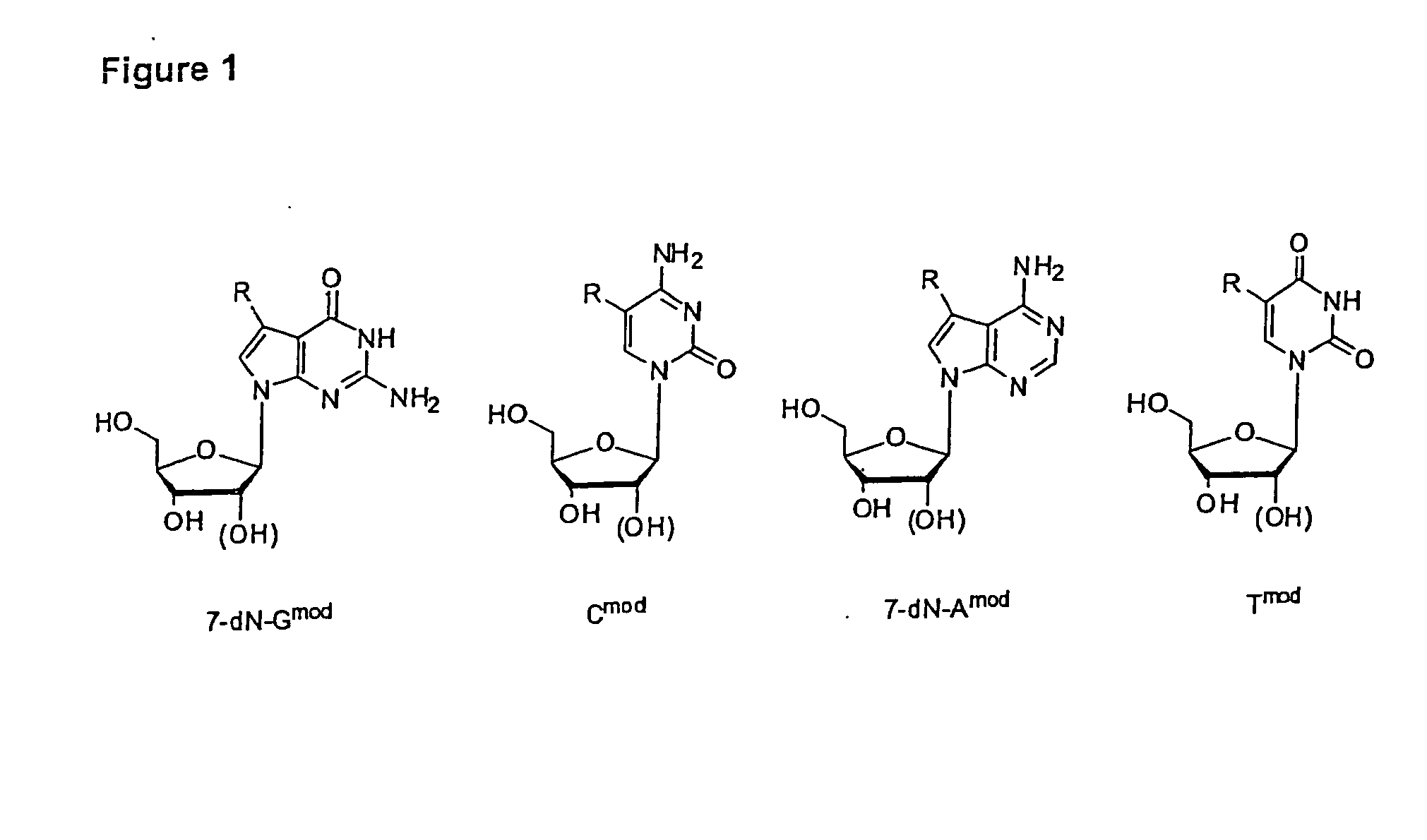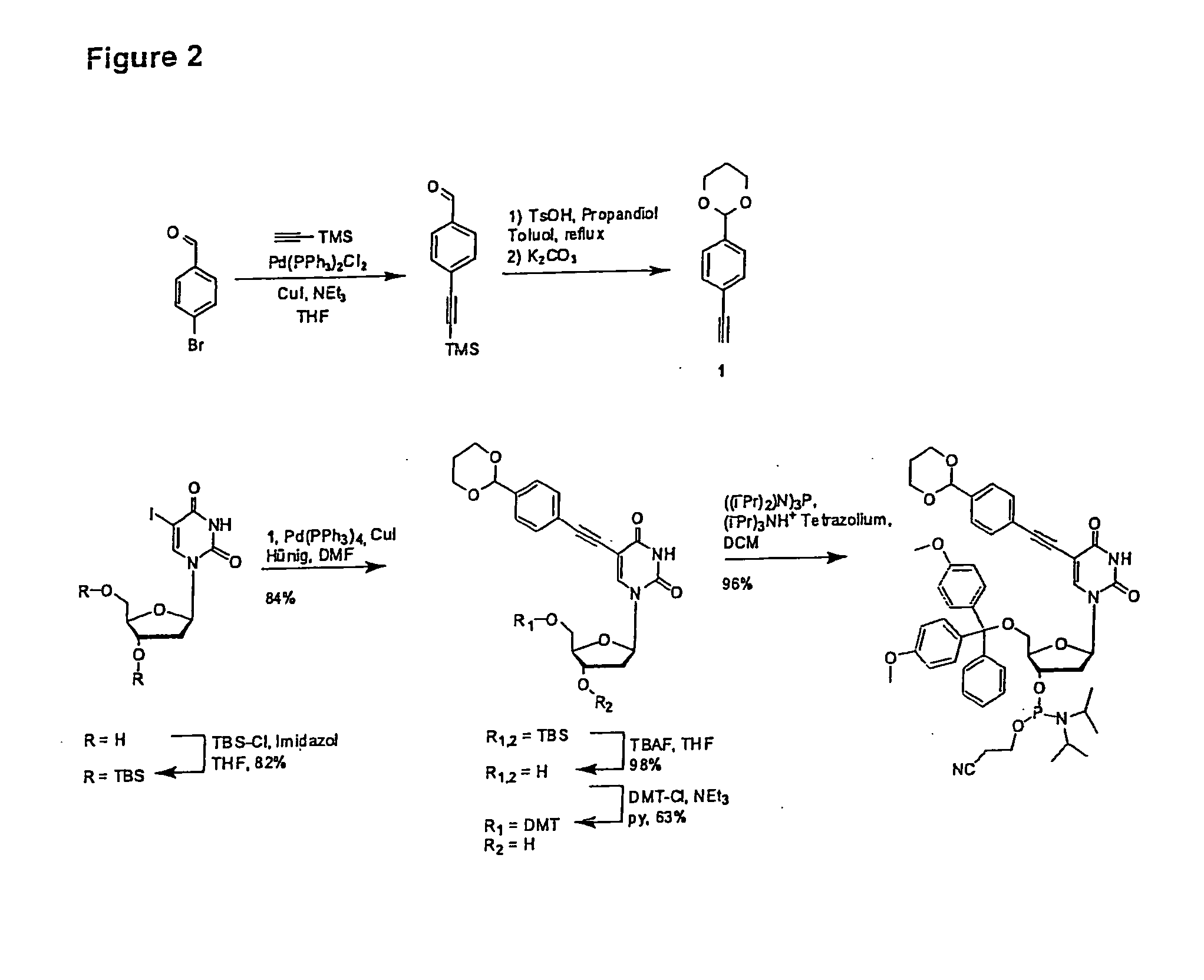Labelling strategies for the sensitive detection of analytes
a technology for labeling strategies and analytes, applied in the preparation of nucleotide libraries, peptides, sugar derivatives, etc., can solve the problems of inconvenient and expensive, need to detect dna or rna, and complex process steps
- Summary
- Abstract
- Description
- Claims
- Application Information
AI Technical Summary
Benefits of technology
Problems solved by technology
Method used
Image
Examples
example 1
Synthesis of Aldehyde-Modified Nucleosides and Nucleotides
[0154]Nucleosides and nucleoside triphosphates with aldehyde-modified nucleobases were synthesized from appropriately modified nucleosides which carry a leaving group such as 1, preferably either on position 5 of pyrimidine bases, e.g. T, U and C or on position 7 of purine bases, e.g. 7-desaza G, 7-desaza A, G and A as shown in FIG. 1. All modifications on these positions protrude out of the DNA major groove.
[0155]The synthesis of an aldehyde-modified T (U) nucleoside phosphoramidite first via Sonogashira mediated alkynylation [20] followed by reaction with appropriate functional groups was performed as shown in FIG. 2. The aldehyde function was kept protected as an acetal group. The acetal protection group may be removed by treatment with acid. The modified nucleoside phosphoramidite may be incorporated into nucleic acids by chemical synthesis.
[0156]The synthesis of an acetal-modified nucleoside triphosphate was carried out ...
example 2
Incorporation of Aldehyde-Modified Nucleosides and Nucleotides into Oligonucleotides
2.1 Incorporation by Chemical Synthesis
[0158]Incorporation of the acetal / aldehyde-modified nucleoside phosphoramidite was achieved by conventional solid phase synthesis [21]. Several DNA oligonucleotides containing one or multiple acetal / aldehyde-modified nucleobases were prepared as depicted in Table 1. Deprotection of the acetal groups afforded the aldehyde-modified DNA oligonucleotide.
[0159]The oligonucleotides were tested for their ability to form base pairs with complementary DNA strands in order to obtain double stranded DNA molecules. It was found that the reduction of duplex stability due to the presence of the aldehyde group is low. The melting point of double strands is lowered by about only 2° C. per modification. This amount of destabilisation is, however, fully acceptable for the intended applications.
TABLE 1Oligodesoxynucleotides synthesised by solidphase synthesis.Tm [° C.]1TTTTTTXTTTT...
example 3
Detection of the Labelled Oligonucleotides and Genes
[0164]A preferred method for the metal deposition on aldehydes is based on the Tollens test [14].
R—CHO+2 Ag[NH3]OH→R—COO−NH4++2 Ag(s)+H2O+NH3
In this reaction a silver-ammonium complex is reduced by the aldehyde. If the concentration of the aldehyde is high, one can see a film of solid silver on the inside of the reaction tube.
[0165]Both the aldehyde containing nucleoside and the chemically synthesised aldehyde-modified nucleic acids could be detected in a silver staining test indicative of aldehyde functions (FIG. 4). An unlabeled DNA strand gave in contrast a clearly negative result under the same conditions, showing that the aldehyde selectively introduced into specific DNA sequences allow selective detection of these modified sequences.
[0166]Detection of aldehyde-modified nucleic acids by silver staining was also carried out on gels. The aldehyde groups on the DNA were sufficient to reduce the silver ions within a gel. The seed...
PUM
| Property | Measurement | Unit |
|---|---|---|
| flexible | aaaaa | aaaaa |
| fluorescent | aaaaa | aaaaa |
| fluorescence | aaaaa | aaaaa |
Abstract
Description
Claims
Application Information
 Login to View More
Login to View More - R&D
- Intellectual Property
- Life Sciences
- Materials
- Tech Scout
- Unparalleled Data Quality
- Higher Quality Content
- 60% Fewer Hallucinations
Browse by: Latest US Patents, China's latest patents, Technical Efficacy Thesaurus, Application Domain, Technology Topic, Popular Technical Reports.
© 2025 PatSnap. All rights reserved.Legal|Privacy policy|Modern Slavery Act Transparency Statement|Sitemap|About US| Contact US: help@patsnap.com



